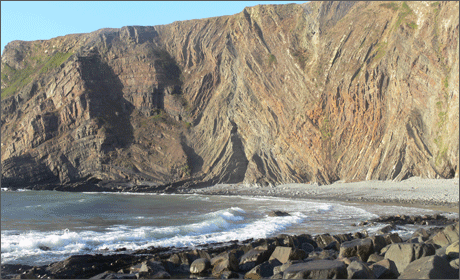
Hartland Quay, Devon © Rob Larter
The cliffs at Hartland Quay in North Devon display a spectacularly folded sequence of alternating grey shales and sandstones known as the Crackington Formation that was deposited in the Carboniferous period approximately 320 million years ago.
From the Late Devonian to the Early Permian, rocks in the south west of the UK were subjected to an episode of major mountain building called the Variscan Orogeny. This tectonic event occurred as a result of the northward convergence and collision of the continent of Gondwana (present day South America, Africa, Antarctica, Australia and India) with the continent of Laurasia (present day Europe, Russia and North America). This collision eventually resulted in the closure of the ancient Rheic Ocean, which lay between the two continents, and the formation of the supercontinent Pangea in the early Permian (approx. 290Ma).
During the Variscan Orogeny, as Gondwana moved progressively further north, the Rheic Ocean basin became compressed and folded to form a fold mountain belt - the Variscan Orogen. Immense crustal thickening associated with the growing mountain belt caused the lithosphere ahead of the mountain belt to flex downwards. Pre-existing extensional basins that had formed in the early Devonian became foreland basins ahead of this thickened and shortened crust. One of these foreland basins was the Culm Basin, the rocks of which now make up present day Devon and Cornwall.
Rivers flowed from areas of high land in Wales out southwards into the Culm Basin, carrying fine sediment which settled out on the sea floor as muddy layers, eventually becoming shales. Periodically, submarine ‘avalanches’, triggered by earthquakes, carried flows of much coarser sediment mixed with water down onto the ocean floor. These are called turbidity currents and they deposited layers of fining-upward sands across the steep slopes and floor of the Culm Basin, which eventually became the interbedded sandstones seen in Hartland Quay. Ripples and grooves preserved as casts can be found on the underside of the sandstone beds, known as sole structures, as a result of the turbidity currents ripping up and gouging the underlying muddy sea floor as the coarser sand was deposited.
As the Variscan Orogeny continued the ocean between Gondwana and Laurasia narrowed further and the foreland basins ahead of the mountain belt became compressed. The alternating shale and sandstone sequences laid down in the Culm Basin became intensely buckled and tightly folded and raised above sea level to become the remarkable folds, observable in Hartland Quay today.
Leveridge &Hartley (2006) The Variscan Orogeny: the development and deformation of Devonian/Carboniferous basins in SW England and South Wales, The Geology of England and Wales Geological Society of London 225-255.
Warr (2009) The Variscan Orogeny: The welding of Pangaea, Geological History of Britain and Ireland, John Wiley & Sons, 2009.
Twinned with: Zagros Mountain Range
The Zagros Mountains make up a belt of deformed crustal rocks located in south eastern Iran. They extend for over 1500km from eastern Turkey in the northwest through to the Gulf of Oman in the southeast. The Zagros Mountains form an important part ...Continue reading